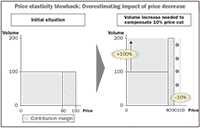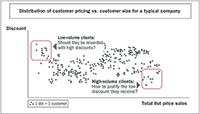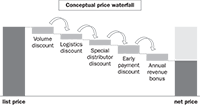Surviving the Emerging Market Price Wars: Three Myths & Three Lessons
How big Pharma stalwarts can avoid a corrosive battle of attrition with local competitors and instead obtain the long-term goal of a stable pricing environment.
In ancient Greece, King Pyrrhus of Epirus fought and defeated the Roman army twice during what is now known as the Pyrrhic wars. However, victory was achieved at an ultimately unsustainable cost because of the high burden of casualties. The story is an apt comparison to the far more prosaic challenge of building a pricing strategy in today's fast-changing emerging markets, where companies are enmeshed in ruinous price wars that destroy value and profits for all parties involved.

Photo: Thinkstock
One recent example, from 2012, involves one of the top 10 manufacturers in Brazil. The company, a leading MNC, wanted to preserve its market leadership and was under pressure from the distribution chain. Discounts on the list prices of its products had reached as high as 95% below those of its major competitors. Coupled with an expected increase in demand ahead of a tax increase, the result was that products from the company flooded the distribution channels. This led to a steep loss in selling power, with many products returned to the manufacturer near their expiration date. And guess who had to foot the bill?
Overall, this strategy led to losses of several hundred million dollars for the company in only one quarter. It was a figure higher than the earning loss from the worldwide patent expiration of one of the multinational company's key blockbuster products. The predicament it faces in Brazil is unfortunately all too familiar to the many manufacturers that strive to beat the performance norm for emerging markets at all costs.
Cash is king
Regardless of recent economic turmoil, key emerging markets remain a significant source of growth for drug companies. While some MNCs haven't fulfilled their ambitious growth targets in emerging markets, Bayer Healthcare and Sanofi are succeeding; emerging markets already account for 30% of their revenues. According to IMS Health, retail sales of pharmaceuticals in Brazil surpassed those of key developed markets like Canada and the UK in 2010 and continue growing at double-digit rates. However, one important characteristic of emerging markets is that most business originates from patients paying out-of-pocket, as opposed to sales funded by the government or private payers, as is common in developed markets. This especially holds true for chronic conditions retail drugs and much less for high-cost drugs such as biologics.
In India, more than 95% of the pharmaceutical expenditure is out-of-pocket, while in China and Brazil patients pay 65% and 80% of the cost of medicines out-of-pocket, respectively. These high rates are only in part due to the limited involvement of public payers in overall health spending. A more important factor is the growth of an emerging middle class with discretionary income that can be spent on products that are not funded through third-party sources.
Pricing out-of-pocket: A different game
Many companies are struggling to maximize their profitability in the out-of-pocket market. There are some important peculiarities that are often overlooked, but need to be considered when designing a strategy for this segment.
» The patient is the main decision-maker: Unlike what happens in reimbursed markets, mere clinical evidence is insufficient to support the value of the product and trigger the buying decision. Apart from perceived clinical benefits, patients will consider other perceptual attributes like the reputation of the manufacturer or even recommendations from family and friends. Looking at the list of top-selling drugs in China, for example, most of the products from MNCs lost patent protection years ago, yet still achieve significant sales. In this sense, the behavior of the patient is more similar to what is seen in the consumer goods industry, where products with a strong perceived brand can avoid comparisons based only on price. More importantly, trust in the brand is vital in the many emerging markets where drug quality and counterfeit products are real issues of concern.
» Importance of stakeholders in distribution channels: Distribution channels involve many players, but sales tend to originate from only a few key accounts. These are typically large retailers with the negotiating power to force manufacturers to offer steep discounts. In Brazil, many manufacturers see 70% or more of their sales coming from just two retail chains.
» Lack of regulated margins: Unlike in many mature markets, retail margins are not fixed by law in many emerging markets. Net prices can be set freely below maximum prices.
» Fierce competition from established local generics: Most of the growth in emerging markets has been captured by local companies specializing in generics. Generic penetration is very strong in emerging markets. In India, for instance, the volume uptake of generics is more than 99%. Many of these manufacturers compete aggressively on price based on low productions costs in order to gain market share. Nevertheless, some of the local companies have managed to stay out of this race to the bottom and are very profitable; the Brazilian company Aché is an example.

Deconstructing myths
The drastic price drops that occur as a consequence of competitive price wars have a destructive impact on the entire market for medicines. All the companies involved—manufacturers and distributors—see their margins decrease significantly. What is worse, most will face difficulties recovering their lost margins. The destruction is in many ways unnecessary because companies will often engage in price wars based on false assumptions—we call them myths:
» 1st myth: "Low prices will drive volume and therefore profit"
Guided by an appreciation of pure volume-based incentives, management may think a price decrease will increase demand for their products. However, such a cut has two consequences: A volume increase and a margin decrease. Therefore, the total impact on profits depends on the strength of the volume increase, which is determined by the elasticity of the price. Price elasticity—which is a function of the consumer's response—predicts how much demand will change when prices change.
According to our latest research work on global pricing, most managers tend to overestimate the positive impact of a price decrease on volumes, while they underestimate the negative impact on margins. Figure 1 shows a scenario where a manufacturer with a gross margin of 20% decides to decrease its price by 10%. In order to maintain the same profit, the manufacturer would have to double the sales it had before the price decrease. This would require a price elasticity of -10 (i.e., volumes need to increase 10 times the price decrease). This is much higher than the elasticity of innovative branded products, which is typically between -0.2 and -0.7. Even generics do typically not have a price elasticity exceeding 2.5. The manufacturer, in this example, is, therefore, very likely to have a lower profit after the price decrease.

Figure 1: The above depicts an outcome scenario where a manufacturer with a gross margin of 20% decides to decrease its price by 10%.
» 2nd myth: "Our competitor started the war, so we should react by lowering our prices"
Companies hardly ever admit or realize that they started a price war. According to Simon-Kucher's Global Pricing study, when managers were asked who started the price war, almost 90% of them answered: "It was the competitor." Some companies truly believe their business is like a battlefield, where the competitor must be destroyed. However, war and business have two key differences: (1) All wars end at some point, but in a free market, there will always be competition; and (2) There are no customers in the battlefield, so companies should focus on responding to customer needs, not destroying the competitor.
The profit loss caused by a price decrease is usually greater than the loss caused by a decrease in market share. In addition, reacting to a price decrease of the competitor with a similar price cut typically starts a vicious circle of price cuts, since the competitor will try to maintain the original price difference. For this reason, the best possible reaction when the competitor lowers prices is to not change prices. In the end, lowering prices only intensifies the price war with disastrous consequences for the profits of all manufacturers involved.
» 3rd myth: "When the war ends, we will increase the prices"
Most managers would agree that a price increase is never easy. There are three facts that support that this also holds true for price increases after price wars.
First, competitors always endure the attack for a longer time than what was initially estimated, making it difficult to end the war. Price wars always last more and cost more money than expected. There is never a "winner," as there will always be competitors in the market. If competitors vanish, it is only because the margins are so low that it is no longer worth competing in the market.
Second, it is very difficult to increase prices to patients used to a low-price level, especially when price is the sole attribute manufacturers focus on.
Third, a price increase will also increase margins, making the market attractive again to competitors, which means a new war may loom soon.
Brazil's biggest maker of generic drugs and hygiene products, Hypermarcas, sets a real-life example on how to exit from a price war. In 2011, Hypermarcas was immersed in a price war against other competitors by offering big discounts and granting favorable payment conditions to distributors to gain market share. As its profit margins declined, Hypermarcas made a difficult decision: reducing discounts and shortening payment terms. Some key clients suspended their orders for several months; however, as soon as they ran out of stock, they placed new orders. Following a loss of $50 million in 2011, Hypermarcas posted a net profit of $100 million in 2012.
Is there a silver bullet to end price wars?
It is easy to deconstruct myths about pricing, but, unfortunately, there is no silver bullet to end all price wars and increase profitability. Pricing is a key internal process that companies need to address holistically, from strategy development to price setting to price execution. However, we can outline three action items a company should consider to minimize the risk of price wars:
» Quantify the impact before lowering the price: Before lowering prices by giving discounts or price promotions, every manufacturer must be able to answer these three questions:
1. How much more volume would need to be sold to reach at least the same level of profits as before the price decrease? This can be easily calculated with the current gross margin.
2. Is price elasticity high enough to achieve those volumes? As we have seen, if the required price elasticity is far from the elasticities typically seen in the market segment, is it realistic to believe such volume increase is possible?
3. How would the volumes and profits be affected if the competitors react and match the price decrease? Never underestimate the ability of competitors to further undercut their prices.
Making a price decision without a clear answer to these questions is very dangerous. When competitors lower their prices, many managers follow suit without considering the consequences on profits in the short and the long run.
Don't give away discounts without compensating for it: Sales reps or account managers frequently offer unnecessary discounts that undermine the company's profitability, as a result of the lack of a clear commercial policy. In many cases, the best conditions are granted to the worst clients. Very often, an analysis of discount structures surprisingly shows no correlation between the discount to a client and the volume or other variables related to the importance of the client (see Figure 2).

Figure 2: An analysis of discount structures shows no correlation between the discount to a client and the volume or other variables related to the importance of the client.
Another useful exercise is the analysis of the price waterfall that is illustrated in Figure 3. It shows what happens between the list price and the net price for each customer. Startlingly, the real net price per customer is not even available on a per-product basis in many cases. The level and structure of discounts is often not linked to the strategic importance of the different customer segments.

Figure 3: Illustrates what happens between the list price and the net price for each customer.
Typically, a redesigned pricing process to consistently reward strategically important customers and limit discounts for underperforming clients can increase return on sales by 200 to 500 basis points. Optimizing trade terms is a complex task, but the resulting optimal discount structure may actually be very simple. Some of the most profitable pharmaceutical companies in Brazil are a few local companies. They grant discounts based on a commercial policy with only a few product categories and limit discount levels to an absolute minimum.

Rewarding good customers with higher discounts can be dangerous, as it can foster concentration of buying power, which can then be turned against the manufacturer that offers them.
An example of a company that successfully addressed ruinous competition between its customers is AstraZeneca in Mexico. In 2009, the company came up with a disruptive solution to put an end to increasing demands for discounts from competing distributors. A uniform retail price across Mexico was introduced, a move that favored small pharmacies and limited further concentration of buying power. Exclusive distributors were paid a fee for service instead of working based on margins. Wal-Mart was initially lost as a client, but now most of the MNC pharmaceutical companies have switched to this business model as well. This example also illustrates the importance of seeking legal guidance before making any pricing decision, as implementing a similar solution in other markets requires considering local anti-trust regulations.
Understand different patient segments and choose your battles: Significant income inequalities in emerging markets lead to different segments of patients with a broad range in terms of willingness to pay. Identifying these segments is crucial in defining the product and price strategy of the portfolio. For example, in China, a population segment of 13 million has an income of at least $25,000 per year; their willingness to pay is very different from the 400 million that earn $5,000 per year or less. If manufacturers want to reach the bottom of the pyramid, they need to assess the profit impact of potentially significant discounts on products currently serving the top of the pyramid.

These income inequalities may justify significant price reductions that are typically not advised in mature markets. A price cut that allows a manufacturer currently focusing on the top of the pyramid in China to reach out to the middle of the pyramid by offering a moderate discount may pay off. However, this still requires doing the math on the volume implications of the price change, which may vary a lot by product.
Within this context, it may be necessary to go beyond factors related to volumes and revenues and look to other considerations such as policy and corporate social responsibility, which will ultimately contribute to the bottom line. For example, from a short-term financial perspective, the optimal strategy for a drug may be to set a high price, reaching the very top of the income pyramid only. However, this may lead to reactions by advocacy groups, which could eventually trigger government actions such as price controls or even compulsory patents, with a negative impact on the bottom line.
A potential strategy to target the different segments of the pyramid is to offer a broad portfolio of clearly differentiated products serving different patient segments. A well-executed price differentiation strategy will often yield a superior result compared to an across-the-board cut of products currently serving the top of the pyramid.
The end game: Peace instead of Victory
By applying these three rules, manufacturers will not win price wars, but will be one step closer to not even starting them—or at least knowing how to get out of them. Pyrrhus, the King of Epirus exclaimed after his second victory: "If we are victorious in one more battle, we shall be utterly ruined." With this in mind, drug manufacturers in emerging markets will hopefully no longer fight battles that they can't win.

Ken Genenz is Director of Simon-Kucher & Partners' Emerging Markets Competence Center. He can be reached at ken.genenz@simon-kucher.com. Cova López-Sors and Rafael Alencar are Senior Consultants at the Emerging Markets Competence Center.
